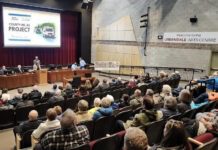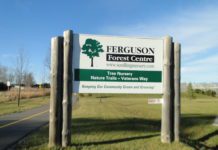After the end of the American Revolutionary War, about 50,000 refugees sought refuge in the lands still held by Britain. Most of these went to Nova Scotia to settle in the territory that became New Brunswick. Others had settled around the forts at Niagara and Detroit, which remained in British hands. But around 6,000 took up land grants on the north side of the St. Lawrence River. Under the terms of the Royal Proclamation of 1763, the Crown had to take a surrender of this territory, which the 1763 document had set aside as Indian Territory. Meetings were held in 1783 when some of the land was “purchased” from the Mississauga for clothing and some weapons. The extent on the north of this tract was defined as “as far as a man can travel in a day”.
The land on which North Grenville and Merrickville-Wolford was surveyed was claimed by Haudenosaunee who were settled at a mission at Oswegatchie (now Ogdensburg), a mission founded in 1848. The Oswegatchie themselves, named after the mission site on the Oswegatchie River, had a number of villages on the north shore of the St. Lawrence near present day Johnstown. These had once contained almost 400 families. By 1784, however, this had shrunk to about 500 men, women and children.
Colonel Campbell, a military official, was sent to meet with the Oswegatchie in 1784, in order to acquire the lands north of the St. Lawrence, between the Long Sault and Jones Creek, which is just west of modern day Brockville. After some negotiation, the Oswegatchie agreed to allow the British to have “the Front of the Water”, in order to “give lands to the troops”. Discharged soldiers were to receive free land grants, as were the many civilians, men, women and children, who had become refugees after the war.
Because the border between the new United States and the British lands to the north had not yet been determined, the fort and mission on the south shore remained in British hands. Campbell and the British authorities convinced the Oswegatchie to remove there, leaving the lands on the Canadian side of the river free for settlement.
This they agreed to do, to their eventual disadvantage. By 1796, it had been agreed that the international border would run through the St. Lawrence, leaving Oswegatchie in American hands. In 1806, the U. S. Government forced the Oswegatchie to move from heir villages, and many of them went to Akwasasne at Cornwall, and Onondaga in New York State.
There were a number of problems about this land transaction. To start with, the Oswegatchie claimed that they had not “received one copper” for the lands they ceded to the British. Furthermore, their understanding was that they had only ceded a tract along the shores of the St. Lawrence, hence the phrase, “the Front of the Water”. The British claimed that they had gained all the territory north of the river between the Long Sault and Jones Creek. That land was to include Oxford-on-Rideau, South Gower, and Wolford Townships, as well as the townships surveyed along the river between the two points.
When Theodore DePencier was sent to survey Marlborough Township in 1791, he was confronted by at least one Haudenosaunee warrior at gunpoint, who demanded to know why he was trespassing on Oswegatchie territory. But there was nothing the Oswegatchie could do about the situation, as they had moved across the river and were soon dispersed by the Americans. There was no-one left to contradict the British interpretation of the agreement made in 1784.
It seems that the land now containing the Municipality of North Grenville was acquired by the British Crown in rather dubious circumstances. This was not unusual, and as no sale document exists, and no report was made at the time by those present at the meeting, it seems the land along the entire shores of the Upper St. Lawrence and Lake Ontario was acquired by the Crown for the cost of some clothes and trinkets. To add to the confusion, most of the territory covered by the purchases from the Owegatchie and Mississauga was actually the traditional territory of the Algonquins, who have recently come to a draft agreement with Canada recognising that the land was taken from the wrong people. The story begun in 1784 has yet to come to an end.






Great piece of history. Thank you. Also interested on how the Irish settled in Marlborough Township
North of the Rideau.